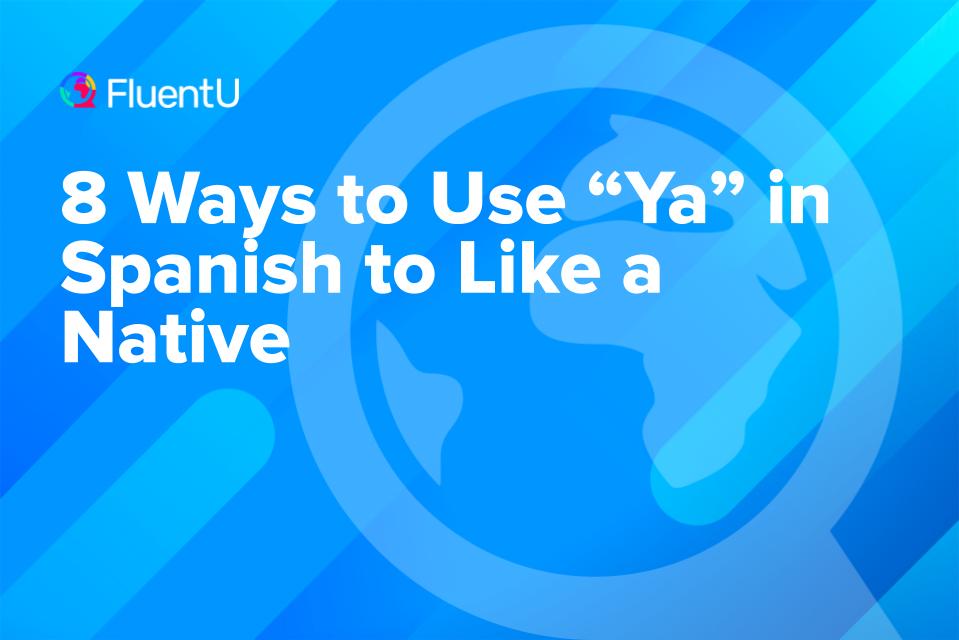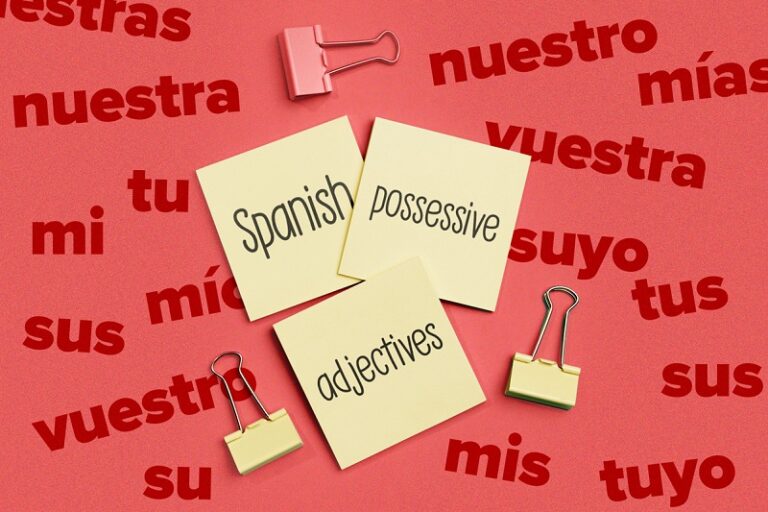8 Ways to Use “Ya” in Spanish to Like a Native

If someone pressed me to give a main meaning to the word ya, I would probably say it means “already.” But actually, ya can be used for different purposes—it all depends on the context of the sentence and the meaning you need to give to it.
There are eight main situations when you need to use ya in Spanish, which we’re about to explain. Plus, learn when to use ya or todavía and the difference between ya and ahora.
Download: This blog post is available as a convenient and portable PDF that you can take anywhere. Click here to get a copy. (Download)
How to Use “Ya” in Spanish
Ya is one of the most common words in Spanish, so it’s important to know how to use it and understand the meaning when you hear it. While it has many different uses, the most common meaning of ya is “now” or “already.” It can also be used to mean “yet” and “any more.”
Ya can be used as an adverb to describe an action and is often used to add emotion to what’s being said. It can express many different emotions depending on the context: impatience, resignation, frustration, excitement, surprise, agreement or even disbelief.
It’s highly common in informal, conversational speech in a casual environment, so listen for it when you’re chatting with friends (or your language partner) or watching a Spanish sitcom.
While ya can be confusing at first, once you get to know it and learn its different uses, you’ll start to use it like a pro in no time.
1. To Mean “Already,” “Yet”
English uses “already” and “yet” depending on whether the sentence is affirmative, negative (see point two) or a question. Spanish uses just one word in all three contexts.
Antonia y Luis se han casado ya. (Antonia and Luis have already gotten married.)
¿Se han casado ya Antonia y Luis? (Have Antonia and Luis gotten married yet?)
There will be instances when you’ll have to use todavía (still) instead of ya, but this will be explained later in the post.
2. To Mean “Not Anymore,” “No Longer,” “Any Longer”
This is another example of the versatility of the word ya in Spanish. While English needs a new set of words (“not anymore,” “no longer” and “any longer” for different contexts), Spanish simply adds no in front of ya and it’s ready to go.
Use ya no when something has stopped happening, is not true anymore or is no longer in process:
Ya no como carne de cerdo. (I don’t eat pork anymore.)
¿Sigues saliendo con Pedro? Ya no. (Are you still going out with Pedro? Not anymore.)
Ya no sé si quiero seguir viviendo aquí. (I don’t know if I want to live here any longer.)
Vine buscando a María pero ya no está. (I came looking for María but she’s no longer here.)
3. To Mean “Now,” “Right Now,” “In a Second,” “Later”
Once again, English gives us four different sets of words that can easily be translated in Spanish with a simple ya.
The words “now” and “right now,” don’t just translate as ya, but they also give a sense of impatience to what’s being said. This impatience can be positive (as in someone looking forward for something) or negative (as in someone losing their patience). It can also add surprise to a question.
Have a look at some examples:
Están llegando ya. ¡Por fin! (They are arriving now. Finally!)
Tenemos que irnos ya. (We have to leave right now.)
¿Ya te vas? (Are you leaving now? — This could also be translated as “Are you leaving already?”)
Ya can also be used for “in a second” and “later,” but often really means much later.
¡Ya voy! (I’m coming!)
Ya se lo diré cuando lo vea. (I’ll tell him later when I see him.)
You can also add the word mismo to mean “right now,” but again, this often really means “in a bit” or “later.” So if you’re meeting a friend and they say they’re leaving their house ya mismo, don’t expect them to show up right away.
4. To Add Emphasis
It’s hard to give a single translation for ya when it’s used to add emphasis. It’d also be weird to translate the sentences literally because many times they’d make no sense in English.
The best way to learn how to use ya to add emphasis is by looking at some examples:
¡Ya te he oído! (I’ve heard you!)
¡Ya era hora! (Finally! / It’s about time! Literal translation: “It was already time.”)
Ya lo sé, pero no puedo olvidarte. (I know, but I can’t forget you.)
Ya quisiera ser millonario. (I’d like to be a millionaire.)
As you can see, if you omit ya in these sentences, they still make sense and the meanings remain the same. We’re just adding emphasis to what we’re saying.
However, there are two expressions Spanish native speakers use a lot that are also used to add emphasis but have a special translation in English. They are:
- Ya puedes + infinitive — you better + infinitive
Ya puedes ponerte a trabajar. (You better start working.)
Ya puedes dejarme solo. (You better leave me alone.)
- Que ya es decir — which is saying something
Corre más rápido que yo, que ya es decir. (He runs faster than me, which is saying something.)
Esa podría ser la peor idea que hayas tenido, que ya es decir. (That could be the worst idea you’ve ever had, which is saying something.)
5. To Indicate Frustration
Similarly to four, ya is mainly used to indicate frustration just as an added word to otherwise normal sentences. It can also appear in some expressions that are uttered when we express how frustrated we are about something:
¡Ya basta! (Enough! Lit. “It is enough already.”)
¡Ya te vale! (You’re a piece of work! / Now you’ve really done it! Lit. “It already costs you.”)
¡Ya está! (That’s it! Lit. “It is already.”)
6. To Reassure Someone
Ya can also be used at the beginning of a sentence in order to calm down someone or reassure them. Very often, the sentences will start with Ya verás… (You will see…):
Ya verás qué bien nos lo vamos a pasar. (You’ll see how much fun we’re going to have.)
Ya verás que todo va a estar bien. (You’ll see everything is going to be fine.)
7. To Express Incredulity
There’s one Spanish expression that I often use when I don’t believe what someone has just told me. I love it because it shows the power of language in just one word (well, two if you count repetitions). It has a sibling which looks very similar and means practically the same:
- ¡Ya, ya! (Sure! [said with maximum incredulity])
- ¡Ya, seguro! (Yeah, sure!)
8. Use Ya Que to Mean “Since”
Ya que is mainly used to mean “since” at the beginning of a sentence. It’s rather formal in Spanish, but it will wow your native friends if you use it. Its informal version is como:
Ya que no quieres quedarte, coge todas tus cosas y vete. (Since you don’t want to stay, take all your stuff and go.)
Ya que vas a casa de Andrés, dale este libro. (Since you’re going to Andrés’ house, give him this book.)
Differences Between Ya and Similar Words
Ya and Todavía
Even though these two words are used in different situations, they tend to be mixed up many times.
The key to understand when to use each of them is the following:
- Use ya and ya no when you want to mean “already” and “no longer / any more,” respectively:
Ya he llegado. (I’ve already arrived.)
Ya no te quiero. (I don’t love you any more.)
- Use todavía and todavía no when you want to mean “still” and “not yet,” respectively:
Todavía estoy aquí. (I’m still here.)
Todavía no ha llegado. (He hasn’t arrived yet.)
But what happens with questions? We know English normally uses “yet” in questions, but sometimes you need to use other words in order to make the meaning clear. If you see ya or todavía in a question, the better way to avoid confusion is to translate them literally (“already” and “still,” respectively):
¿Ya estás aquí? (You are already here?)
¿Todavía estás aquí? (You are still here?)
Ya and Ahora
Ya can easily be confused with ahora because they play a similar role when talking about the present. In fact, we can often use them interchangeably to mean “now”:
¡Deberías llamarla ya / ahora! (You should call her now!)
However, when we want to say “already” we can use ya but not ahora:
¿Ya has escrito a tu mamá? (Have you already written to/texted your mom?)
Le estoy escribiendo ya / ahora. (I’m writing/texting her now.)
In this case, you can’t use ahora in the first question, but you could use either word to mean “now” in the response.
There you have it! Now you know all the different meanings of the Spanish word ya and can better understand (and sound like) native Spanish speakers.
If you’re still a bit confused, don’t worry. By paying attention to the context whenever you see or hear the word, you’ll soon catch on and start using it freely to express yourself in different ways.
One way to see how ya is used in different situations is by exposing yourself to some real Spanish media. You can find authentic videos featuring native speakers on FluentU.
FluentU takes authentic videos—like music videos, movie trailers, news and inspiring talks—and turns them into personalized language learning lessons.
You can try FluentU for free for 2 weeks. Check out the website or download the iOS app or Android app.
P.S. Click here to take advantage of our current sale! (Expires at the end of this month)

So get practicing, ya!
Download: This blog post is available as a convenient and portable PDF that you can take anywhere. Click here to get a copy. (Download)
And One More Thing…
If you've made it this far that means you probably enjoy learning Spanish with engaging material and will then love FluentU.
Other sites use scripted content. FluentU uses a natural approach that helps you ease into the Spanish language and culture over time. You’ll learn Spanish as it’s actually spoken by real people.
FluentU has a wide variety of videos, as you can see here:

FluentU brings native videos within reach with interactive transcripts. You can tap on any word to look it up instantly. Every definition has examples that have been written to help you understand how the word is used. If you see an interesting word you don’t know, you can add it to a vocab list.

Review a complete interactive transcript under the Dialogue tab, and find words and phrases listed under Vocab.

Learn all the vocabulary in any video with FluentU’s robust learning engine. Swipe left or right to see more examples of the word you’re on.

The best part is that FluentU keeps track of the vocabulary that you’re learning, and gives you extra practice with difficult words. It'll even remind you when it’s time to review what you’ve learned. Every learner has a truly personalized experience, even if they’re learning with the same video.
Start using the FluentU website on your computer or tablet or, better yet, download the FluentU app from the iTunes or Google Play store. Click here to take advantage of our current sale! (Expires at the end of this month.)







